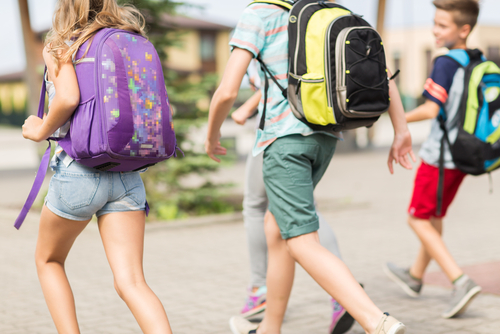The start of the school year can be stressful when dealing with a new scoliosis diagnosis. We often get questions about backpacks- what type is best? How heavy should it be? How should it be worn?
For children and teens with scoliosis, a traditional backpack is best. Both shoulder straps should be worn snuggly, with the backpack sitting firmly against your back. Tighten up those straps! Try to avoid wearing the backpack low on your hips, and avoid using just one shoulder strap slung over your shoulder. If your backpack has an extra strap that clasps across the center of your chest or low across your waist, use it!
A “roller bag” is not necessary, and can even result in unwanted trunk rotation while trying to roll your backpack along beside or behind you. If it’s time for a new backpack, pick one with a few compartments rather than one large space.

When packing your backpack, less is more! Don’t need something until Thursday? Take it out until then! Avoid carrying extra items, as they add unnecessary weight. Things like heavy metal water bottles, for example, may weigh as much as 3-4 pounds when full- while a light plastic water bottle may only weigh 1-2 pounds when full.
Pack lunches in lighter plastic tupperware rather than heavier glass, or wrap items in a lighter wrapping like wax paper or a paper towel. The overall goal is to get the backpack down to 10% of your body weight or less. For your average growing teen that is usually a 8-12 lb limit. That is a nearly impossible goal these days, with textbooks, tablets and laptops often being required in class on a daily basis. Do what you can to get as close to that goal as possible, even if you need to go over a little.
Don’t forget to clean your backpack out every once in a while, as there are often items that get forgotten, lost, or crammed to the bottom adding extra weight. When packing large textbooks and laptops, try to place these heavier items in the compartments closest to your back.

If your backpack has straps along the sides that can tighten and reduce the amount of baggy empty space, tighten them as much as possible. This prevents items from falling away from your body, resulting in your muscles working harder to keep you upright and balanced.
If you find yourself having pain while wearing your backpack, take it off when you aren’t walking around. Remove your backpack if you are standing at the bus stop- just make sure you use good mechanics when picking it back up from the floor.
During National Spine Awareness Month in October, Jessica Giddings, DPT and medical assistant Nadine Kramer from Hey Clinic had a chance to talk with WRAZ’s Michelle Mackonochie about bad backs and backpacks and shared some of the above tips.

